#Merica Tour, Stories from the Road, Segment 23
(For links to previous segments, scroll to the bottom)
It’s a hot, sunny morning outside in St. Paul as Brent and I sit in his kitchen, running through our options. It’s my last day in town, our road trip was a complete success as we arrived back safe and mostly sound, and my laundry is currently dirtying up Brent’s washer since my clothes have done some serious living lately. But my flight doesn’t leave MSP until 7 p.m., giving us ample time to plan a local venture.
 “Do you remember the candy store?” Brent asks.
“Do you remember the candy store?” Brent asks.
“The yellow one?”
“That’s it.”
“Is it open?”
He laughs. “It’s open this time.”
A year, maybe two ago, we drove through the rolling hills of Minnesota on our way to a candy store that sounded too good to be true, but Brent said they had the best root beer. After a lazy day adventure, we arrived to find the giant store was closed and wouldn’t open for the season for another week. So, of course we hung out in the parking lot and watched through the windows as workers restocked shelves and readied displays. I was preparing my argument for knocking on the door “just to have a look and not to buy anything, I swear,” when Brent reminded me we had a Wes Anderson movie waiting for us at a historic theater. I have yet to step foot inside the candy wonderland.
“Or we can go to the State Fair,” Brent tosses out there.
“Everything on a stick? Hmm, that’s tough,” I say. “But, I want to do both.”
“You can’t do both.
We negotiate this, based on Brent’s argument of Time-Space-Relativity in relation to getting to the airport on time and my argument of Sure We Can.
“Well, we’ve been to the State Fair before,” I say. “But I’ve not been inside the giant candy store.”
Candy store it is. And after a hearty breakfast of junk food, we’re on our way.
Back in the Jetta—you’d think we’d be sick of it by now—we remind each other what happened the last time we tried to go to the candy store, about finding a sinking barn that we decided looked as if a giant had stepped on it. And then there was this long, lolling road through two fields where we could see what I can only describe as a giant armadillo up ahead.
I laugh as the scenery rolls by. “I remember saying, ‘Is that an armadillo?’”
Brent agrees. “From far off, I had no idea.”
Turns out, it was not an armadillo, which are not native to Minnesota, but a massive snapping turtle with an armored, spiky tail and a shell nearly two feet tall. The turtle was crossing the road–and making good time about it, too. Brent stopped the car to give the turtle room, and we just stared in amazement. We had driven most of the day without another car in sight, and now suddenly there were about five cars behind us, all of us waiting for this giant turtle because Brent had stopped the car mid-road. When the turtle got by the Jetta (the same Jetta), I cheered, “Go, turtle, go!” which prompted this massive creature to turn around fully and look at me, eye to eye. I half expected him to wear little glasses and say hello. We drove on, and Brent and I spent the rest of the trip to the candy store coming up with the perfect name for such a turtle, a dignified and masterful name: Mr. R. Sullivan. And the mind of this writer began weaving a children’s book.
Back at present, we drive along Highway 169, following a long span of bright yellow farm fence that leads to the yellow barn.
 Minnesota’s Largest Candy Store, which is part of Jim’s Apple Farm, is barely contained in a long yellow barn that seems as though someone expanded it, one section at a time, about six times. The heat of the day is surging and we’re excited to get inside to some candy and air conditioning, but we take some time to check out the pumpkins and to threaten each other with the watering hose in the parking lot before finally setting foot inside.
Minnesota’s Largest Candy Store, which is part of Jim’s Apple Farm, is barely contained in a long yellow barn that seems as though someone expanded it, one section at a time, about six times. The heat of the day is surging and we’re excited to get inside to some candy and air conditioning, but we take some time to check out the pumpkins and to threaten each other with the watering hose in the parking lot before finally setting foot inside.
 And what awaits us is astounding. Immediately to the right are rows and aisles and tables and shelves of brightly-colored candy, sectioned off by type from hard candies, caramels, flavors of taffies, chocolates, lollipops, gumballs, European candies—over 3,000 types of candy from around the world–as far as the eye can see. In front of us is a section of homemade pies, jams and jellies, brittles, and fudge, and also a section of meats and jerkies. To the left is a section of glass grocery refrigerators filled to the brim with multicolored sodas.
And what awaits us is astounding. Immediately to the right are rows and aisles and tables and shelves of brightly-colored candy, sectioned off by type from hard candies, caramels, flavors of taffies, chocolates, lollipops, gumballs, European candies—over 3,000 types of candy from around the world–as far as the eye can see. In front of us is a section of homemade pies, jams and jellies, brittles, and fudge, and also a section of meats and jerkies. To the left is a section of glass grocery refrigerators filled to the brim with multicolored sodas.
 The story goes that what began as a family-owned business, Jim’s Apple Farm, expanded into selling candy to offset a couple bad apple years. (Hopefully with the Minnesota-developed Honeycrisp, those days are far behind us.) And now, it’s still family-owned, cash-only, sans website and sans telephone though it does have a Facebook page, and the business has grown and grown.
The story goes that what began as a family-owned business, Jim’s Apple Farm, expanded into selling candy to offset a couple bad apple years. (Hopefully with the Minnesota-developed Honeycrisp, those days are far behind us.) And now, it’s still family-owned, cash-only, sans website and sans telephone though it does have a Facebook page, and the business has grown and grown.
 The building is filled with happy nostalgia (Pac-Man Band-Aids!), delicious discoveries (orange fudge!), and new favorites like candies in the shape of Pixar’s Minions. There’s even a shelf of puzzles in their own section among the candy. And in the corner sits a full-size TARDIS, the Doctor Who time machine that travels between worlds. Brent and I, clutching our prized candy and root beer, run to it and act out crash scenes and do our favorite monster impressions.
The building is filled with happy nostalgia (Pac-Man Band-Aids!), delicious discoveries (orange fudge!), and new favorites like candies in the shape of Pixar’s Minions. There’s even a shelf of puzzles in their own section among the candy. And in the corner sits a full-size TARDIS, the Doctor Who time machine that travels between worlds. Brent and I, clutching our prized candy and root beer, run to it and act out crash scenes and do our favorite monster impressions.
 Everywhere we look is something we remember from childhood, something that evokes a memory big or small. For me, a slogan I memorized at a Pennsylvania amusement park (Idlewild?) comes to mind: “Where Childhood is Eternal and Imagination is King.”
Everywhere we look is something we remember from childhood, something that evokes a memory big or small. For me, a slogan I memorized at a Pennsylvania amusement park (Idlewild?) comes to mind: “Where Childhood is Eternal and Imagination is King.”
 And in the middle of what feels like an action-packed candy store, I pause and muse that Brent, with all of his reason and rationale, and I, with my heart leading the way, both explore our surroundings with childlike wonder. And with that acknowledged, I dive back into the fray.
And in the middle of what feels like an action-packed candy store, I pause and muse that Brent, with all of his reason and rationale, and I, with my heart leading the way, both explore our surroundings with childlike wonder. And with that acknowledged, I dive back into the fray.
–We’re not done yet! The final episode is coming soon!
~ Jody Brown is the author of Upside Down Kingdom, and is a blogger, poet, and traveler.
(For previous Stories from the Road, click here: Segment 22, Segment 21, Segment 20, Segment 19, Segment 18, Segment 17, Segment 16, Segment 15, Segment 14, Segment 13, Segment 12, Segment 11, Segment 10, Segment 9, Segment 8, Segment 7, Segment 6, Segment 5, Segment 4, Segment 3, Segment 2, Segment 1)

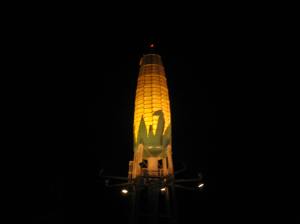
 world.) As it stands, we’ll head to Newt’s for some late-night food.
world.) As it stands, we’ll head to Newt’s for some late-night food.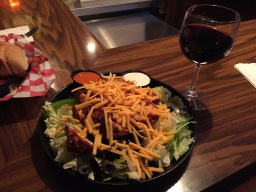 Do you see why we love this place? We head up to Newt’s, sidle up to the bar, and proceed to pig out. I get my favorite: beer battered fried chicken salad with buffalo sauce. Brent gets a giant burger and I help him eat his fries. Full and happy, I check the time and note that we have very little of it before
Do you see why we love this place? We head up to Newt’s, sidle up to the bar, and proceed to pig out. I get my favorite: beer battered fried chicken salad with buffalo sauce. Brent gets a giant burger and I help him eat his fries. Full and happy, I check the time and note that we have very little of it before 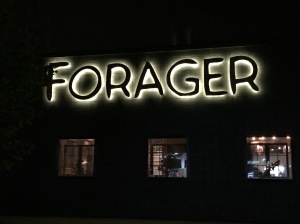 We drive the handful of blocks away from downtown and closer to the highway and make a right. There before us is the backlit sign I had seen on Facebook. “There it is!” I say, and I can’t keep my excitement down. Back when I was getting ready to move to Pittsburgh, this place was just an idea in my friend Annie’s mind and the subject of excited chatter in the building where my writing studio was next door to Forager’s architect. Months and months (a year?) later, and after many Facebook progress reports from a variety of local artists who were brought in to apply their talents, here it is, right in front of me.
We drive the handful of blocks away from downtown and closer to the highway and make a right. There before us is the backlit sign I had seen on Facebook. “There it is!” I say, and I can’t keep my excitement down. Back when I was getting ready to move to Pittsburgh, this place was just an idea in my friend Annie’s mind and the subject of excited chatter in the building where my writing studio was next door to Forager’s architect. Months and months (a year?) later, and after many Facebook progress reports from a variety of local artists who were brought in to apply their talents, here it is, right in front of me. As we close in on
As we close in on  What we didn’t expect are the myriad people who drive past us on the small side road and honk, wave, and whistle at us as we take our usual array of serious photos. We could be journalists at this point. Or maybe pet photographers (with a good deal of training.)
What we didn’t expect are the myriad people who drive past us on the small side road and honk, wave, and whistle at us as we take our usual array of serious photos. We could be journalists at this point. Or maybe pet photographers (with a good deal of training.) 

 “Let’s backtrack and start again,” I say just as Brent says, “I think it’s further.” We try my way first (of course we do) and it doesn’t work (of course it doesn’t), but we’re able to rule out a strange turnoff that seemed to lead to railroad tracks. We then try Brent’s way and we find the marker. We hadn’t missed it because it was never behind us; it was always ahead.
“Let’s backtrack and start again,” I say just as Brent says, “I think it’s further.” We try my way first (of course we do) and it doesn’t work (of course it doesn’t), but we’re able to rule out a strange turnoff that seemed to lead to railroad tracks. We then try Brent’s way and we find the marker. We hadn’t missed it because it was never behind us; it was always ahead. The marker is on a little knoll and has its own small driveway off the road, which allows us to spend a little time here without worrying about being in the roadway. The marker, a plaque, denotes the first train robbery made by
The marker is on a little knoll and has its own small driveway off the road, which allows us to spend a little time here without worrying about being in the roadway. The marker, a plaque, denotes the first train robbery made by  And the plaque itself, which is mounted on a train wheel, has a story of its own: Years ago, it was stolen. And it wasn’t until the thief’s house in Ohio burned down that the marker was found and returned.
And the plaque itself, which is mounted on a train wheel, has a story of its own: Years ago, it was stolen. And it wasn’t until the thief’s house in Ohio burned down that the marker was found and returned. We’re Googling this story as a Cadillac suddenly pulls up the small driveway and a man and woman emerge to join us. This is a first. We’re usually alone at these roadside curiosities.
We’re Googling this story as a Cadillac suddenly pulls up the small driveway and a man and woman emerge to join us. This is a first. We’re usually alone at these roadside curiosities.

 Brent stops the Jetta about ten yards from the intersection, just in case someone would come by, and we sit staring, blinking, then staring some more. “That’s a tree,” I say, as I stare and blink.
Brent stops the Jetta about ten yards from the intersection, just in case someone would come by, and we sit staring, blinking, then staring some more. “That’s a tree,” I say, as I stare and blink.
 The more we look around, touch the tree, and photograph it, the more it seems not to have grown up from the ground but to have landed here, set apart and at its full majesty. It seems a trick of the mind, like an
The more we look around, touch the tree, and photograph it, the more it seems not to have grown up from the ground but to have landed here, set apart and at its full majesty. It seems a trick of the mind, like an 
 We’re on the west side of Iowa, driving east toward a giant
We’re on the west side of Iowa, driving east toward a giant  I oblige, and we sit with our candy cigarettes as the wind whips around us in the car. We’re giddy and gritty and feeling like champions of the road, so I take a picture of us like this. As I post it to Facebook, a friend’s post catches my eye. “Hey!” I say. “We’re stopping in Rochester for dinner, right?”
I oblige, and we sit with our candy cigarettes as the wind whips around us in the car. We’re giddy and gritty and feeling like champions of the road, so I take a picture of us like this. As I post it to Facebook, a friend’s post catches my eye. “Hey!” I say. “We’re stopping in Rochester for dinner, right?” We find it, curl the car around to the left, and there, under a tree in the middle of a neighborhood, is the
We find it, curl the car around to the left, and there, under a tree in the middle of a neighborhood, is the  “Okay,” he says without hesitation, and hops out of the car. Three seconds later I follow him out, having processed multiple thoughts simultaneously, the way only computers and dreamy brains can do. My first conclusion: It’s up to me. Brent doesn’t care if I sit in the car or not, and I know he’ll never think a cross thought about it. I also know he needs someone to take his picture with the spider. Second conclusion: We’ve come this far. This road trip was never about the destination; we could have flown to Denver easily enough to see
“Okay,” he says without hesitation, and hops out of the car. Three seconds later I follow him out, having processed multiple thoughts simultaneously, the way only computers and dreamy brains can do. My first conclusion: It’s up to me. Brent doesn’t care if I sit in the car or not, and I know he’ll never think a cross thought about it. I also know he needs someone to take his picture with the spider. Second conclusion: We’ve come this far. This road trip was never about the destination; we could have flown to Denver easily enough to see  I exit the Jetta and cross the small street in four paces. Brent is standing under the spider contraption, taking pictures straight up. I sit in the grass underneath it and look up. From this vantage point, it’s especially impressive.
I exit the Jetta and cross the small street in four paces. Brent is standing under the spider contraption, taking pictures straight up. I sit in the grass underneath it and look up. From this vantage point, it’s especially impressive.


 Rejuvenated, and with my sense of wonder restored again, Screen Candy and I hop back in the Jetta, ready to experience more of what myopics mistakenly call America’s “flyover country.”
Rejuvenated, and with my sense of wonder restored again, Screen Candy and I hop back in the Jetta, ready to experience more of what myopics mistakenly call America’s “flyover country.” #Merica Tour, Stories from the Road, Segment 18
#Merica Tour, Stories from the Road, Segment 18 She’s developing an attitude. Warnings pop up on my phone that it’s dangerously hot and I need to shut down immediately or else, so I do and set it down on the air vent by my feet. Now I’m navigating the old fashioned way with my eyes and a map while Brent uses his chill, un-snarky phone.
She’s developing an attitude. Warnings pop up on my phone that it’s dangerously hot and I need to shut down immediately or else, so I do and set it down on the air vent by my feet. Now I’m navigating the old fashioned way with my eyes and a map while Brent uses his chill, un-snarky phone.
 It’s also convenient for lounging in the sunshine on the tracks while we take it all in and puzzle it out—until Brent and his camera turn on me. (I need to take that camera away from him.)
It’s also convenient for lounging in the sunshine on the tracks while we take it all in and puzzle it out—until Brent and his camera turn on me. (I need to take that camera away from him.)


 Safely across the Viaduct, I can now figure out what the heck just happened. According to
Safely across the Viaduct, I can now figure out what the heck just happened. According to 
 We follow Sally the Map App’s cranky instructions for finding a giant spaghetti fork and find ourselves, instead, at the
We follow Sally the Map App’s cranky instructions for finding a giant spaghetti fork and find ourselves, instead, at the  To our left is a 13-foot stainless steel fork with spaghetti in its tines. We sit in the car for a moment, deliberating, and one of us deduces that, “Look, if they didn’t want us to take pictures of it, they wouldn’t have put it there.” I’m not sure which of us says that, but it sounds an awful lot like me. That settles it, and we get out of the car. For most of our shenanigans up to now, we’re pretty much on public property or have the owner’s express permission. Today we’re in someone’s yard, without permission, in the interest of discovery and trying not to look like troublemakers. We walk a fine line.
To our left is a 13-foot stainless steel fork with spaghetti in its tines. We sit in the car for a moment, deliberating, and one of us deduces that, “Look, if they didn’t want us to take pictures of it, they wouldn’t have put it there.” I’m not sure which of us says that, but it sounds an awful lot like me. That settles it, and we get out of the car. For most of our shenanigans up to now, we’re pretty much on public property or have the owner’s express permission. Today we’re in someone’s yard, without permission, in the interest of discovery and trying not to look like troublemakers. We walk a fine line.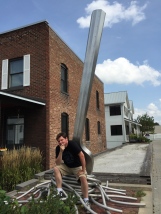
 Even the neighboring houses with their large windows, flower boxes, and close placement to each other resemble a gathering of intimate friends around this fork and pasta.
Even the neighboring houses with their large windows, flower boxes, and close placement to each other resemble a gathering of intimate friends around this fork and pasta. “I’m checking us in on Facebook,” I tell him. “There, we’re at the zoo parking lot,” I show him my phone. Now it’s official. We vow to plan a return trip to Omaha just to see the zoo and especially the Desert Dome, which is visible for miles as we drive in Omaha.
“I’m checking us in on Facebook,” I tell him. “There, we’re at the zoo parking lot,” I show him my phone. Now it’s official. We vow to plan a return trip to Omaha just to see the zoo and especially the Desert Dome, which is visible for miles as we drive in Omaha.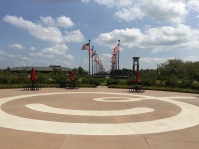 Against Sally’s protests and our own excitement at spending a day at the zoo, we head toward downtown, stop in the beautiful Visitor’s Center where they let us touch things, and find
Against Sally’s protests and our own excitement at spending a day at the zoo, we head toward downtown, stop in the beautiful Visitor’s Center where they let us touch things, and find 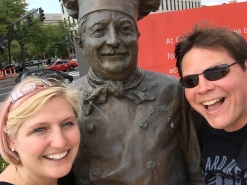 The story goes that
The story goes that 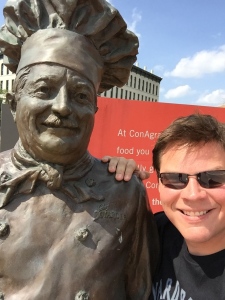 The Chef opened his own restaurant in Cleveland where he was known for sending his guests who would ask home with milk jars filled with his spaghetti sauce. In the 1920s, he helped his inlaws, who owned a chain of local grocery stores, to engineer his canning process and put his Italian foods on the shelves locally and beyond with the help of their wholesale partners. To keep up with demands, they opened a factory in 1928, and ten years later, production was moved to Milton, Pennsylvania where greater quantities of tomatoes and mushrooms could be grown.
The Chef opened his own restaurant in Cleveland where he was known for sending his guests who would ask home with milk jars filled with his spaghetti sauce. In the 1920s, he helped his inlaws, who owned a chain of local grocery stores, to engineer his canning process and put his Italian foods on the shelves locally and beyond with the help of their wholesale partners. To keep up with demands, they opened a factory in 1928, and ten years later, production was moved to Milton, Pennsylvania where greater quantities of tomatoes and mushrooms could be grown.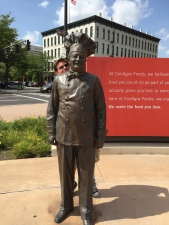 Then—hear this–during WWII his factory was commissioned to produce army rations for the Allied troops, requiring the factory to run 24/7 and earning the Chef a Gold Star Order of Excellence from the U.S. War Department. When the war ended, it was decided that they sell the company rather than reduce production so that no jobs would be lost. That’s decency in America, and it’s a chord deep inside each and every one of us.
Then—hear this–during WWII his factory was commissioned to produce army rations for the Allied troops, requiring the factory to run 24/7 and earning the Chef a Gold Star Order of Excellence from the U.S. War Department. When the war ended, it was decided that they sell the company rather than reduce production so that no jobs would be lost. That’s decency in America, and it’s a chord deep inside each and every one of us.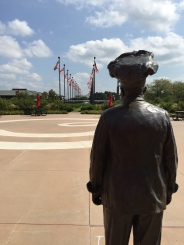
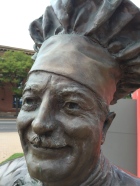 With the statue’s kind face and with our familiarity having grown up on all things Boyardee, Brent and I find ourselves hugging the statue as if we’ve run into a long-lost relative on the streets of Omaha.
With the statue’s kind face and with our familiarity having grown up on all things Boyardee, Brent and I find ourselves hugging the statue as if we’ve run into a long-lost relative on the streets of Omaha. We’re tracking down a giant masonry head, which doesn’t seem like it’ll be too hard to find. The giant head sits atop the
We’re tracking down a giant masonry head, which doesn’t seem like it’ll be too hard to find. The giant head sits atop the  I think about the
I think about the 


 Instead, we gas up and mill around the parking lot studying our vantage point to the giant coffee pot, rea
Instead, we gas up and mill around the parking lot studying our vantage point to the giant coffee pot, rea We wait and wait and finally get across, take some photos with Brent’s direction as the road is suddenly silenced, and then wait to return across the once-again super busy street. “This is so very
We wait and wait and finally get across, take some photos with Brent’s direction as the road is suddenly silenced, and then wait to return across the once-again super busy street. “This is so very 
 As I carefully choose one signed by Alexis with a Love stamp right on the top center, a couple enters from a side doorway and the man asks, “Aren’t you worried that someone will make a bigger one?
As I carefully choose one signed by Alexis with a Love stamp right on the top center, a couple enters from a side doorway and the man asks, “Aren’t you worried that someone will make a bigger one? I pay for my Alexis stamp ball and we head through the doorway. “I’m sending two more to ya, Hank!” the gift shop lady calls into the wide hallway. At the end of the hall ahead of us is the
I pay for my Alexis stamp ball and we head through the doorway. “I’m sending two more to ya, Hank!” the gift shop lady calls into the wide hallway. At the end of the hall ahead of us is the 
 Hank tells us his service company and says, “There were some nice guys from Pennsylvania there with me.” We talk about Pittsburgh together, and he insists we can touch the stamp ball. So we do. Hank is good at egging us on. Together, we spread silliness all around, and eventually have to say farewell to Hank and to the gift shop lady as we head out to see the
Hank tells us his service company and says, “There were some nice guys from Pennsylvania there with me.” We talk about Pittsburgh together, and he insists we can touch the stamp ball. So we do. Hank is good at egging us on. Together, we spread silliness all around, and eventually have to say farewell to Hank and to the gift shop lady as we head out to see the  Father Edward J. Flanagan started his home for boys around the time of WWI, and moved the home to where we’re standing, at what was formerly the Overlook Farm back in 1921. According to
Father Edward J. Flanagan started his home for boys around the time of WWI, and moved the home to where we’re standing, at what was formerly the Overlook Farm back in 1921. According to 
 The streets are easy to navigate and we easily find the
The streets are easy to navigate and we easily find the  The story goes that inventor
The story goes that inventor  As any successful artist, entrepreneur, business owner, cowboy, adventurer, musician, brewer, traveler, writer, etc., will undoubtedly say, in creating anything, there is failure. It comes down to what you do with that failure. I close my eyes and imagine Perkins in his mother’s kitchen, and all of his stages of experimentation along the way. For Edward Perkins and Kool-Aid, this is where it started, the desire, the belief, the drive, the problem solving, and the refusal to give up, right here in the middle of America, in Hastings, Nebraska.
As any successful artist, entrepreneur, business owner, cowboy, adventurer, musician, brewer, traveler, writer, etc., will undoubtedly say, in creating anything, there is failure. It comes down to what you do with that failure. I close my eyes and imagine Perkins in his mother’s kitchen, and all of his stages of experimentation along the way. For Edward Perkins and Kool-Aid, this is where it started, the desire, the belief, the drive, the problem solving, and the refusal to give up, right here in the middle of America, in Hastings, Nebraska. As Brent continues with his pictures, I search the posters and finally find what I’m looking for. “Berry Blue!” I burst out in a wave of memory and I start talking fast, as if I’d just drunk the deliciously sugary stuff. “That was my favorite! First it was orange, and I thought it was the best, but then Berry Blue had this blueberry/lemon combination and I couldn’t get enough of it…”
As Brent continues with his pictures, I search the posters and finally find what I’m looking for. “Berry Blue!” I burst out in a wave of memory and I start talking fast, as if I’d just drunk the deliciously sugary stuff. “That was my favorite! First it was orange, and I thought it was the best, but then Berry Blue had this blueberry/lemon combination and I couldn’t get enough of it…”
 Next to the bushes that line the parking lot is a slab of cement, with no real lighting on it and certainly no giant Kool-Aid Man statue pointing at it. (I suppose most people show up in the daytime, so they don’t need such markers.) Triumphant, and without needing to wait in line, we put our feet inside the giant footprints and Brent does his best Kool-Aid Man imitations.
Next to the bushes that line the parking lot is a slab of cement, with no real lighting on it and certainly no giant Kool-Aid Man statue pointing at it. (I suppose most people show up in the daytime, so they don’t need such markers.) Triumphant, and without needing to wait in line, we put our feet inside the giant footprints and Brent does his best Kool-Aid Man imitations.
 The sun is lowering in the sky as we arrive at the
The sun is lowering in the sky as we arrive at the  Inside the store, immediately to my left, I find a bin of candy cigarettes. “Look!” I gasp. “I didn’t think they made these anymore!” I launch myself at the bin. Brent has turned right and found himself an old time peep show machine.
Inside the store, immediately to my left, I find a bin of candy cigarettes. “Look!” I gasp. “I didn’t think they made these anymore!” I launch myself at the bin. Brent has turned right and found himself an old time peep show machine. I drag Brent away from the peep show, and we find aisles and aisles of Western hats, sheriff badges, wooden horses, magnets, candy… We wander through the store, playing with everything. I mean everything. Other tourists start following in our wake, sharing their own road stories with us.
I drag Brent away from the peep show, and we find aisles and aisles of Western hats, sheriff badges, wooden horses, magnets, candy… We wander through the store, playing with everything. I mean everything. Other tourists start following in our wake, sharing their own road stories with us.  As Brent rides around on a stick horse, one couple asks us if we found the covered wagon out the back door.
As Brent rides around on a stick horse, one couple asks us if we found the covered wagon out the back door. “Nobody mentioned this,” Brent says, and I know he’s referring to his carefully arranged seven-page list of roadside stops.
“Nobody mentioned this,” Brent says, and I know he’s referring to his carefully arranged seven-page list of roadside stops.
 The Fort Cody jail doesn’t have a guitar and a crumpled hat like the Argo jail in Colorado, and it doesn’t have a mannequin jailer and Wanted posters like the Abilene jail in Kansas—come to think of it, how many Wild West lockups have we seen on this trip? (A few days from now, my 4-year-old nephew will look through my photos and ask, “Why is Aunt Jody always in jail?” I’ll tell him, to my sister’s delight, Because I don’t eat my vegetables.”)
The Fort Cody jail doesn’t have a guitar and a crumpled hat like the Argo jail in Colorado, and it doesn’t have a mannequin jailer and Wanted posters like the Abilene jail in Kansas—come to think of it, how many Wild West lockups have we seen on this trip? (A few days from now, my 4-year-old nephew will look through my photos and ask, “Why is Aunt Jody always in jail?” I’ll tell him, to my sister’s delight, Because I don’t eat my vegetables.”)  Here in Nebraska we have our own props: the not-quite-yet-paid-for candy cigarettes and sheriff badges. We just can’t pass up a good jail.
Here in Nebraska we have our own props: the not-quite-yet-paid-for candy cigarettes and sheriff badges. We just can’t pass up a good jail. Finally back in the store again, we check out the museum area. We find a two-headed calf, which Brent thinks is awesome and I, well, don’t. “It’s heartbreaking,” I say, but Brent refuses to agree. Thankfully, it’s not for sale, and I can’t believe how many times I need to remind him of that. He keeps looking from me to the calf and back again, waiting for that information to change. In times like this, his face can be as telling as a peep show: The movie reel of his mind pops up and look! It’s us, riding down the open road with Two-Head strapped into the passenger seat while I’m relegated to the backseat with a big fat frown, arms crossed…
Finally back in the store again, we check out the museum area. We find a two-headed calf, which Brent thinks is awesome and I, well, don’t. “It’s heartbreaking,” I say, but Brent refuses to agree. Thankfully, it’s not for sale, and I can’t believe how many times I need to remind him of that. He keeps looking from me to the calf and back again, waiting for that information to change. In times like this, his face can be as telling as a peep show: The movie reel of his mind pops up and look! It’s us, riding down the open road with Two-Head strapped into the passenger seat while I’m relegated to the backseat with a big fat frown, arms crossed…
 In the mid-1800’s, America’s West had not been safe for man nor beast and everyone was pitted against one another—some for
In the mid-1800’s, America’s West had not been safe for man nor beast and everyone was pitted against one another—some for 
 Before leaving North Platte, we stop next door for gas–mostly because Brent spied a green dinosaur outside the station–and we’re back on the road again. This time, we’re tracking down Kool-Aid.
Before leaving North Platte, we stop next door for gas–mostly because Brent spied a green dinosaur outside the station–and we’re back on the road again. This time, we’re tracking down Kool-Aid. “Look at that,” I point it out to Brent. I take a picture and think about all the people who talked to us in the Trading Post. “I like these people,” I tell him and breathe in deeply. “Nebraska,” I say. Who knew?
“Look at that,” I point it out to Brent. I take a picture and think about all the people who talked to us in the Trading Post. “I like these people,” I tell him and breathe in deeply. “Nebraska,” I say. Who knew?